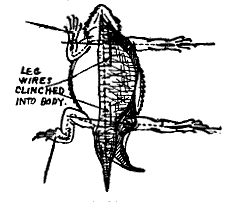 Taxidermy supplies and tips
Taxidermy supplies and tipsLearning taxidermy
History of taxidermy
Bird taxidermy
Coyote taxidermy
Deer taxidermy
Fish taxidermy
Skinning fish
Mount fish skin
Skinning turtle
Mount turtle
Mounting lizard<
Mounting crawfish
Muskrat taxidermy
Squirrel taxidermy
Taxidermy panels and shields
Making animal fur rugs
Taxidermist hunting
Taxidermy mounting kits
Other resources
Mounting lizard
Preparing and mounting a small lizard.
A horned toad is a good example for us to work out in this department. Skin the specimen as you would a small mammal, except that body incision runs from jaw to tip of tail and skull is left attached to face-skin. Keep the skinned carcass in alcohol for reference in making the hard wrapped excelsior body. Mount
as you would a bird specimen, except that all leg-wires are set solid same as the two legs of the bird are.
The lizard's leg bones are wired exactly as in a bird and are wrapped with tow or cotton to replace muscles. Wire neck and tail and put the specimen together as shown in Fig. 29.

Position the specimen and wire upon a temporary base. Set eyes same as in turtles. When dry finish in same manner as a turtle.
In large lizards a light covering of compo. No. II may be employed over a hard wrapped core, but is not so satisfactory as dry mounting
as the skins of lizards are water-proof and consequently do not allow of moisture evaporating. With care in application the first mentioned method may be employed upon nearly all lizard specimens with most satisfactory results.
Alligators may be mounted with wrapped legs and tail and stuff ed body, like the small mammal method with the exception of the head.
Be sure to remove all the jaw meat, tongue, and eye socket fat from the skulls of lizard specimens. Replace tongue and other tissues
with colored wax and cotton when mouth is opened.
(Apply the wrapped body principle discussed earlier, to
mount small snakes, using a wire through center.)

